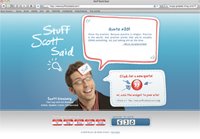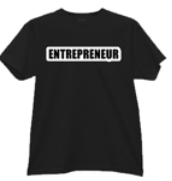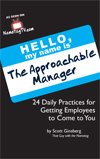 When you walk in the door for your next interview, just remember:
When you walk in the door for your next interview, just remember:
You’re not there to answer their questions.
You’re there to articulate your fabulousness.
You’re there to tell people what they need to hear to fall in love with you.
You’re there to make it impossible for the interviewer to escape your awesomeness.
IN SHORT: You’re there to deliver a marketing presentation for yourself.
Not literally, of course. Breaking out the flip chart might be a little heavy handed. Not to mention, those smelly markers might get you accidentally buzzed.
Instead, here’s a collection of practices for becoming more presentable:
1. Don’t over prepare. Study the organization. Review your notes. Google your interviewer. Eat breakfast. Do breathing exercises. Maybe listen to The Rocky Soundtrack in the car. Other than that, you don’t want to prepare TOO much. As my public speaking mentor William Jenkins always reminds me, “Your life is your preparation.”
Remember: What’s past is prologue. Go give that interviewer everything you’ve got. Use all that you’ve experienced up until this point to blow the doors of this mother. They won’t help but be taken over by your performance. What’s your interview preparation process?
2. Flip the focus. Steve Hughes, owner of Hit Your Stride, is a Presentation Coach and keynote speaker. He suggests that although your interview is (technically) a marketing presentation for yourself, nobody cares about you. The secret is flipping the focus. “The more THEY talk, the more they’re going to like you,” Steve said.
“Just like a delivering a speech, make your audience (in this case, the interviewer and the company) the star of the interview. Turn it into a true dialogue, not a monologue. Nobody wants to hear you ramble on about yourself.” Ultimately, it’s about being future oriented.
Whether you’re giving a speech to a thousand people or being interviewed by the HR Director of a potential employer, remember this: Your past is what got you in the door – but THEIR future is what will keep you in the room. How can you flip the focus of this presentation?
3. Be funny early. Humor is the ONLY universal language. And people want to spend their workdays with people who make them smile. So, when you introduce it early in the interview, several advantages stack in your favor: You diffuse defensiveness, you relax the situation, you break down barriers, you soften the ground and you stimulate memory.
What’s more, funny means listening. Funny means approval. Funny means trust. Funny means attention. And funny means engagement. The secret is, everyone is funny. The challenge is tapping into your natural humor. In the book Throwing the Elephant: The Art of Managing Up, Stanley Bing suggests, “You don’t have to be particularly funny. The attempt to provide amusement is more important that the quality or validity of the amusement itself.”
Don’t make jokes – be funny. Huge difference. One is contrived; the other comes from your core. Pinpoint your natural funniness and share it early. How funny do people perceive you as being?
4. Don’t be shy about going on the offensive. My friend Shari Alexander is the owner of Presenting Matters and an Executive Speech Coach and Professional Communications Expert. She suggests you observe (not only) your own body language – but that of your interviewer too.
“Observe what sparks their posture. And don’t be afraid to say, ‘I noticed you reacted to my last statement by sitting back in your chair. Can you share what you’re thinking?’ This brings their truth to the surface AND pinpoints valuable insight about organization.”
For example, if your interviewer instantly crosses her arms at the mere mention of the word “Twitter,” that’s quite telling about her attitude towards social media. “If you don’t ask the follow-up questions after observing posture shifts,” Shari told me, “you won’t know the ugly truth until you’re already hired and in the middle of it.” Are you playing enough offense?
5. Be a mirror. In an interview with American Songwriter, Bruce Springsteen shared his theory on connecting with his fans, “The audience and the artist are valuable to one another as long as you can look out there and see yourself, and they look back and see themselves.”
Therefore: Your goal is to discover the CPI, or, Common Point of Interest between you and the interviewer. Within sixty seconds. After all, people like whom they ARE like. And conversation is about common ground.
In the same vain of getting your butt off the stage to stand on the same level as the audience, discovering the CPI immediately is secret to being a mirror during your interview. What questions will you ask to discover common ground?
6. Let your personal brand shine. “Interviewing is much deeper than showcasing a collection of skills or preparing great answers to questions you may never hear,” says my friend and career coach John Suarez of Referral Ready, LLC.
“It’s about celebrating your authentic self. The one that relates to the world on a human level AND professional level. The one that helped get you where you are now. The one that leaves a nonverbal impression no words can undo.”
Lesson learned: Don’t spend time all your preparing to be someone you’re not. Instead, dedicate yourself to becoming more of who you already are. How will you allow your distinct youness shine?
REMEMBER: It’s not a job interview – it’s a marketing presentation for yourself.
In summary, I’m reminded of one of George Carlin’s final interviews before passing away. He shared a fascinating insight about presentation and performance:
“Growing up in Harlem in the 1940’s, I attended Bishop Dubois Catholic School. And the best part about our academy was that the nuns never give out grades. Ever. And yet, Still, I managed to get all A’s. See, when I was the class clown in school, I got the only A’s that mattered: Their Attention, their Approval, their Admiration and their Applause.”
In short: Presenting matters.
After all, to present is to give a gift.
The gift of YOU.
LET ME ASK YA THIS…
How will your advance yourself?
LET ME SUGGEST THIS…
For the list called, “45 Questions Every Unemployed Professional Should Ask,” send an email to me, and you win the list for free!
* * * *
Scott Ginsberg
That Guy with the Nametag
Author, Speaker, Coach, Entrepreneur
[email protected]
 Never the same speech twice.
Never the same speech twice.
Always about approachability.
Watch The Nametag Guy in action here!

 “I’m just waiting for my big break!”
“I’m just waiting for my big break!”
 The best way to get people to fall love with you is to help them fall in love with themselves first.
The best way to get people to fall love with you is to help them fall in love with themselves first. “Freeeeeeebirrrrrrrd!!!!!”
“Freeeeeeebirrrrrrrd!!!!!” Who’s quoting YOU?
Who’s quoting YOU? 1. The road to prestige is paved with pandemonium. Not everyone survives success. Becoming too successful, too early and too quickly will harm your health because although money loves speed – velocity creates stress. And stress kills people.
1. The road to prestige is paved with pandemonium. Not everyone survives success. Becoming too successful, too early and too quickly will harm your health because although money loves speed – velocity creates stress. And stress kills people.  You can’t make a name FOR yourself unless you honor the truth OF yourself.
You can’t make a name FOR yourself unless you honor the truth OF yourself.
 In the past few months, I’ve heard numerous people use the term “Bullshit Artist” in reference to certain individuals.
In the past few months, I’ve heard numerous people use the term “Bullshit Artist” in reference to certain individuals. In the beginning, there was a question:
In the beginning, there was a question: Read
Read 
 1. Never apologize for acting on your instincts. Listening to your body – then taking action on what you hear – is the hallmark of heroic people.
1. Never apologize for acting on your instincts. Listening to your body – then taking action on what you hear – is the hallmark of heroic people.